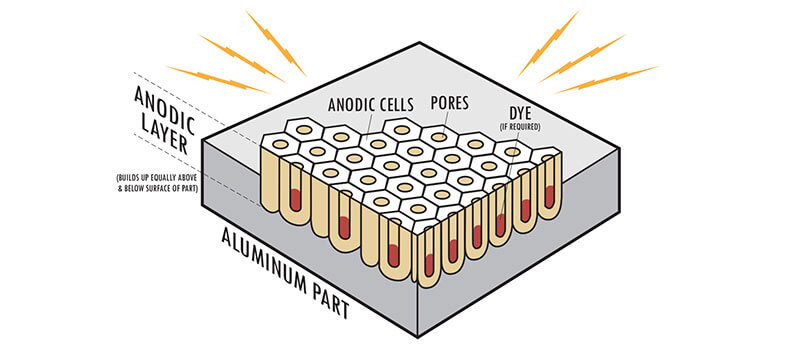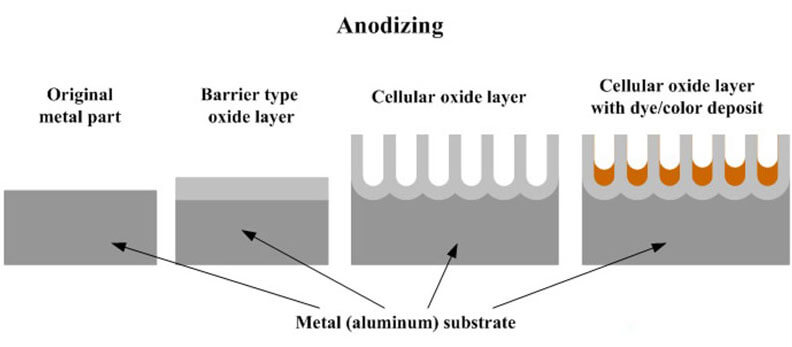
Many metals are structurally weakened by the oxidation process but not aluminum. But anodized aluminum has a surface strength harder than steel.

An anodized surface will show essentially infinite ohms or of course will not allow the test light to light.
How to tell if aluminum is anodized. How to Tell the Difference Between Polished Anodized Aluminum Look at the texture of the metal. Anodized aluminum has a matte finish. Look at the color.
If the piece is painted try to scrape a small amount of paint from an unobtrusive area. Scrape a penny across an unobtrusive portion of the metal. How to Identify if the Anodizing Process is Successful.
Check For Matte Finish. You can usually tell by the matte finish that anodizing creates. Use a Simple Scratch Test.
Scrape a coin on the surface of the aluminum part. If a scratch is visible the part has. A good anodizing.
To anodize aluminum manufacturers submerge aluminum in a bath of acidic anodizing chemicals. An electrical current is then applied to the submerged aluminum which releases hydrogen. This chemical reaction triggers the formation of oxygen on the surface of the metal thus creating a layer of oxide over the surface of the aluminum.
Its a highly technical process that requires specific. Aluminum is a soft metal and anodization is an electrochemical process that gives a metal surface like aluminum a decorative durable and corrosion-resistant finish according to the Aluminum Anodizers Council AAC. The aluminum oxide layer has much higher corrosion and abrasion resistance than the aluminum by itself.
Anodized aluminum helps improve a products lifespan durability and. After coloring anodized aluminum has a characteristic metallic look. This is caused by two factors.
One because of the uniform electro-chemical etching a rough surface is left behind. The deeper the pores the rougher the surface will be but the colors will also be that much more durable. An anodized surface will show essentially infinite ohms or of course will not allow the test light to light.
Dont put the leads on sharp edges or you might get a light on an anodized part. If you think there is a slight amount of anodize on a part hold one lead on a sharp edge and try to scratch a flat surface with the other. You can sometimes scratch through a very thin coating.
The third step is color dyeing if needed. The most common anodizing processes for example sulfuric acid on aluminum produce a porous surface. After immersing the anodized aluminum in an inorganic metal salt bath.
An electric current is applied to this bath as the metal salts oxidize in the aluminums pores. Stan Essentially sealing is an hydration of the Aluminium oxide. The best test you could is to dissolve a dark dye in oleic acid the same present on your finger and put a drop of it onto the anodised surface and remove it with a shower tap.
You can graduate the effects of greasing letting a drop for 1 minute another 2 minute etc. So you can measure the undesired oleophilic properties of. How can you tell if aluminum is anodized.
Scrape a penny across an unobtrusive portion of the metal. Polished aluminum is very soft as all natural aluminum remains. But anodized aluminum has a surface strength harder than steel.
If the penny is able to scratch the finish the material is polished aluminum. Is anodized aluminum safe to cook in. Anodized aluminium surfaces for example are harder than aluminium but have low to moderate wear resistance that can be improved with increasing thickness or by applying suitable sealing substances.
Anodic films are generally much stronger and more adherent than most types of paint and metal plating but also more brittle. This makes them less likely to crack and peel from ageing and wear but more. Film Thickness Measurement The most common means of measuring the thickness of anodized aluminum is the Eddy Current Method Figure 1.
The Eddy Current Method uses a probe that contains a coil. This probecoil is driven by a highfrequency oscillator to. Anodized aluminum is sealed so that the metal cannot leach into food or react with acidic foods.
Unlike ordinary lightweight aluminum pots and pans which are highly reactive with acidic foods like tomatoes anodized aluminum cookware is safe. In anodized aluminum the pores are open after anodizing. Hard anodized aluminum comes with a thick oxide layer which delivers the best wear resistance and durability.
A standard anodized aluminum offers only low to medium cooking. Even it is not safe for oven cooking. Hard anodized is best for cookware as it withstands extreme heat.
The wear resistance is also very high. An anodized aluminum caribiner. Many metals are structurally weakened by the oxidation process but not aluminum.
Aluminum can actually be made stronger and more durable through a process called anodizing. Anodizing involves placing a sheet of aluminum into a chemical acid bath quite often acetone in laboratory experiments. They are made from aluminum that has gone through a treatment process that makes them very durable and somewhat nonstick.
Look for pans labeled. Metals are anodized by placing them in an acidic bath often sulfuric acid and the acid corrodes the metal resulting in a very thick oxide ceramic layer on the metal surface. This oxide layer is porous and can be up to 50 µm thick 2 mils and appear as different colors depending on its thickness.